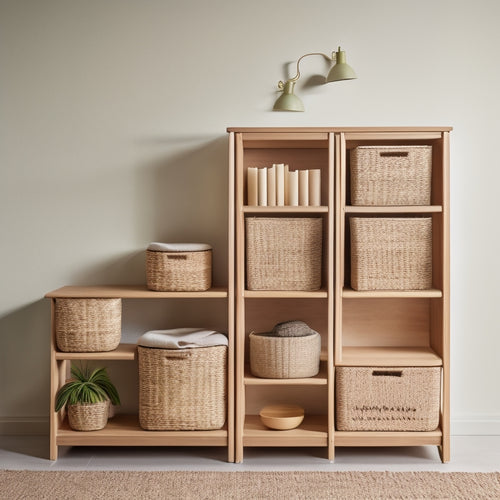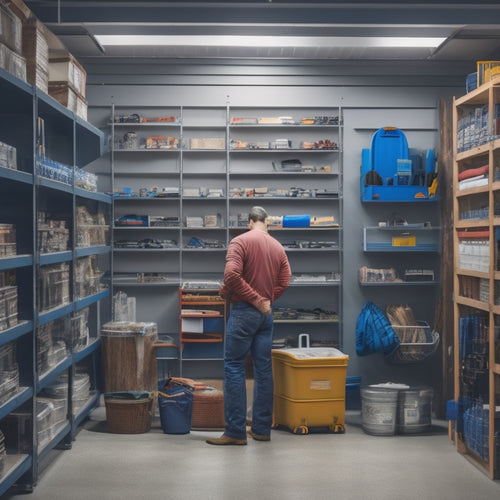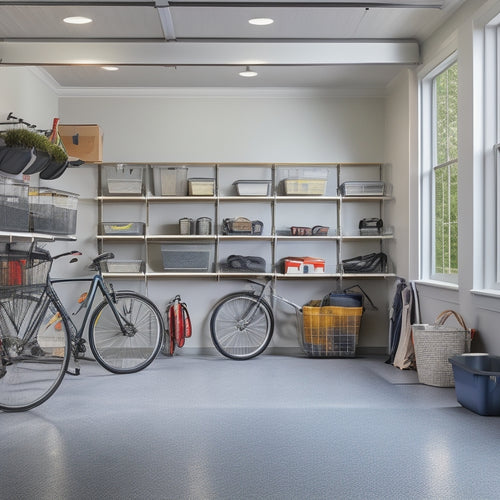
10 Essential Custom Pegboard Design Tips for Workshops
Share
When designing a custom pegboard for your workshop, you'll want to start by defining your needs and goals, then measure your space to optimize the board's placement and size. Choose the right pegboard material and accessories that maximize storage and accommodate your tool needs. Prioritize tool accessibility by designing easy-reach zones and organizing tools into logical groups. Add a personalized touch with custom labels and a complementary color scheme. Finally, test and refine your design to guarantee it boosts your workshop's productivity and efficiency. Now that you've got a solid foundation, take your design to the next level by exploring more expert tips.
Key Takeaways
• Define workshop needs and goals to tailor pegboard design to specific requirements and optimize space usage.
• Measure workshop dimensions and optimize space for pegboard design, considering room layout and workflow.
• Choose the right pegboard material and accessories, ensuring compatibility and maximizing storage space.
• Prioritize tool accessibility by designing easy reach zones and organizing tools into logical groups and task-oriented zones.
• Balance aesthetics and functionality by incorporating brand identity, custom labels, and a complementary color scheme.
Start With a Clear Objective
Define your workshop's specific needs and goals before designing your pegboard to make sure it's tailored to your unique requirements and maximizes productivity. This is where you set the foundation for a successful project. Establishing a clear objective helps you stay focused on what you want to achieve and guarantees your pegboard design meets your workshop's specific needs.
To do this, start by identifying your project scope. What tasks will you be performing in your workshop? What tools do you need to store and organize? What're your pain points, and how can your pegboard design solve them?
Next, set specific, measurable, and achievable goals for your pegboard design. What do you want to accomplish with your design? Do you want to increase storage capacity, improve workflow, or reduce clutter? By setting clear goals, you'll be able to create a design that addresses your workshop's unique challenges and helps you work more efficiently.
Measure Your Workshop Space
What's the exact dimensions of your workshop space, and how can you optimize it to accommodate your pegboard design?
Measuring your workshop space is essential to creating a functional and efficient pegboard. Take out your tape measure and record the length, width, and height of your workshop. Consider any space constraints, such as corners, pillars, or alcoves, that might affect your pegboard's placement.
Next, assess your room layout.
Identify the areas where you spend most of your time and the tools you use most frequently. This will help you determine the best location for your pegboard.
Think about the workflow and traffic patterns in your workshop. You want to position your pegboard in a way that minimizes congestion and maximizes accessibility.
Choose the Right Pegboard
With your workshop space measured and workflow assessed, you're ready to select a pegboard that fits your needs, considering factors like material, size, and accessory compatibility.
When it comes to material options, you'll want to choose between steel, aluminum, or wood. Steel pegboards are durable and resistant to wear, while aluminum ones are lighter and corrosion-resistant. Wooden pegboards offer a more rustic look, but may require more maintenance.
Next, consider the size of your pegboard. Measure your available wall space and choose a board that fits comfortably. Don't forget to think about accessory compatibility – will you need specialized hooks, bins, or other attachments? Research different brands to find one that offers the accessories you need.
A brand comparison can help you identify the best value for your money. Some popular brands, like Pegboard Tool Organizer and WallPeg, offer a range of material options and accessories. By weighing your options carefully, you'll find a pegboard that streamlines your workflow and maximizes your storage space.
Select the Best Hooks
When selecting hooks for your custom pegboard, you'll want to think about a few key factors to make sure you're getting the most out of your storage system.
First, think about the variety of hook types you'll need to accommodate different tool sizes and shapes.
Hook Type Variety
Selecting the right hook type for your pegboard is crucial, as it directly impacts the functionality and organization of your workshop. You'll want to choose hooks that cater to the specific needs of your tools and equipment.
Consider the Hook Material Options:
| Hook Material | Durability | Resistance to Corrosion |
|---|---|---|
| Steel | High | Medium |
| Aluminum | Medium | High |
| Plastic | Low | Low |
When selecting hooks, don't overlook Ergonomic Hook Shapes. Look for hooks with curved or angled ends that allow for easy tool retrieval and minimize strain on your hands and wrists.
You'll also want to think about the variety of hooks you need. Do you require hooks with a wide mouth for larger tools or smaller hooks for precision instruments? Having a mix of hook types will ensure your pegboard is adaptable to your changing needs. By choosing the right hooks, you'll be able to maximize your pegboard's potential and create a more efficient workshop.
Weight Capacity Matters
You'll need to take into account the weight capacity of each hook to make sure it can handle the tools and equipment you'll be hanging, as overcrowding or overloading can lead to damage or even accidents. When selecting hooks, check the load limits to make certain they can support the weight of your tools.
A hook's material strength is vital in determining its weight capacity. For instance, a hook made from heavy-duty steel can handle more weight than one made from aluminum or plastic.
It's essential to take into account the type of tools you'll be hanging. If you have heavy power tools or bulky equipment, you'll need hooks with higher weight capacities. Look for hooks with sturdy construction, a secure grip, and a smooth finish to prevent scratching or damage to your tools.
Don't compromise on quality – invest in hooks that can handle the weight of your tools and equipment. Remember, it's better to err on the side of caution and choose hooks with higher weight capacities to ensure your safety and the longevity of your pegboard.
Easy Hook Swapping
Easy Hook Swapping
Design your pegboard for flexibility by choosing hooks that can be easily swapped out as your tool collection evolves, ensuring your pegboard remains functional and clutter-free. You want to be able to add new tools or adjust your layout without having to reinstall your entire pegboard.
Look for hooks with high hook interchangeability, allowing you to switch between different types of hooks or accessories seamlessly. This feature will save you time and frustration in the long run.
When selecting hooks, consider the frequency of quick reconfigurations you'll need to make. If you have a growing tool collection or frequently work on different projects, you'll want hooks that can be easily swapped out or rearranged. This will enable you to adapt your pegboard to your changing needs, keeping your workspace organized and efficient.
Plan for Tool Accessibility
When designing your custom pegboard, you'll want to prioritize tool accessibility to maximize your workshop's efficiency.
You should identify the tools you use most frequently and place them in easy reach zones, ensuring you can quickly grab what you need without straining or stretching.
Easy Reach Zones
Designate zones on your pegboard for frequently used tools, placing them between waist and shoulder height to minimize stretching and bending. This ergonomic height guarantees you can access your tools comfortably, without straining your back or shoulders. When setting up your easy reach zones, consider the tools you use most often and prioritize them in the most accessible areas.
You'll want to position your most-used tools at a comfortable distance from your body, allowing you to reach them without having to stretch or lean. This will help reduce fatigue and discomfort, making your work sessions more efficient and enjoyable.
For example, if you're right-handed, place your most-used tools on the right side of your pegboard, between waist and shoulder height.
Tool Grouping Strategy
Tool Grouping Strategy
Organize your tools into logical groups based on their function or the tasks they're used for, ensuring that tools used together are positioned in close proximity to streamline your workflow. This will help you create workstation clusters, where related tools are gathered in one area, making it easy to access what you need when you need it. By grouping similar tools together, you'll reduce walking distances and minimize the time spent searching for the right tool.
Task segmentation is key to an efficient tool grouping strategy. Divide your tasks into smaller, manageable chunks, and identify the tools required for each task. This will help you create a clear picture of which tools need to be grouped together.
For instance, if you're working on a woodworking project, you might've a cluster for measuring and marking tools, another for cutting tools, and another for finishing tools. By segmenting your tasks and grouping your tools accordingly, you'll be able to work more efficiently and effectively, and your pegboard will become an extension of your workflow.
Consider Vertical Space
Maximize your workshop's storage capacity by utilizing the often-overlooked vertical space above your workbench, where you can install pegboards that hold bins, baskets, and hooks within easy reach. By doing so, you'll be making the most of your ceiling utilization, an essential aspect of maximizing storage in your workshop. This strategy allows you to keep frequently used tools and supplies organized and accessible, freeing up valuable floor and bench space for more important tasks.
Here are some key considerations to keep in mind when utilizing vertical space:
-
Measure your ceiling height: Make sure you have enough clearance to comfortably access the pegboard without straining or using a ladder.
-
Choose the right pegboard material: Opt for a durable, heavy-duty material that can support the weight of your tools and supplies.
-
Select versatile storage solutions: Incorporate a mix of bins, baskets, and hooks to accommodate different sizes and types of items.
- Consider ergonomic placement: Position the pegboard at a comfortable height to reduce strain and fatigue.
Add a Personalized Touch
Once you've optimized your pegboard's vertical space, it's time to tailor it to your specific needs and preferences by incorporating personalized elements that reflect your unique workflow and style. This is where you get to add a touch of personality to your workshop's pegboard.
You can start by incorporating your brand identity through custom labels, stickers, or even a logo. This won't only make your pegboard look more professional but also help you establish a consistent visual brand.
Next, consider your color scheme. Choose a palette that resonates with your brand's personality or complements your workshop's aesthetic. You can use colored bins, baskets, or even paint to add a pop of color to your pegboard. This will create a visually appealing and cohesive look that sets your workshop apart.
Incorporate Task-Oriented Zones
When designing your custom pegboard, you'll want to create task-oriented zones that boost efficiency and productivity.
To achieve this, you'll need to implement a zone segregation strategy that separates your tools into distinct categories, and develop tool organization systems that make sense for your specific workshop needs.
Zone Segregation Strategy
How can you boost productivity and reduce clutter in your workshop by strategically dividing your pegboard into task-oriented zones? By implementing a zone segregation strategy, you can create a more organized and efficient workspace.
This approach involves dividing your pegboard into distinct areas, each dedicated to a specific task or function.
Here are some tips to help you create effective task-oriented zones:
-
Color Code your zones using different colored bins, hooks, or labels to visually distinguish between areas.
-
Group Similar Tools together in functional clusters, such as a drilling zone or a measuring zone.
-
Designate a Zone for Frequent Tasks, like a quick-access zone for frequently used tools or a dedicated area for ongoing projects.
- Leave Space for Expansion, allowing you to easily add new tools or zones as your needs evolve.
Tool Organization Systems
By incorporating task-oriented zones into your pegboard design, you can take your tool organization system to the next level, ensuring that every tool has a designated home and making it easier to find what you need when you need it.
This approach allows you to categorize your tools based on their functions or tasks, creating a logical and efficient workflow. For instance, you can create separate zones for drilling, cutting, and measuring tools, making it easier to access the tools you need for a specific task.
To make the most of this approach, consider using modular components that can be easily rearranged as your needs change. This dynamic layout will enable you to adapt to new projects and tools without having to overhaul your entire pegboard.
By grouping similar tools together and labeling each zone, you'll be able to quickly identify where each tool is located, saving you time and reducing frustration.
Balance Aesthetics and Function
Your pegboard's visual appeal matters just as much as its functionality, so strike a balance between the two by incorporating design elements that serve a purpose, such as color-coded bins and strategically placed hooks. This balance is essential in achieving visual harmony, a key design principle that guarantees your workshop remains organized and efficient.
To achieve this balance, consider the following design tips:
-
Group similar tools together: This creates a sense of unity and makes it easier to find what you need.
-
Use contrasting colors: This helps to create visual interest and draws attention to specific areas of your pegboard.
-
Incorporate negative space: Leaving some areas of your pegboard empty creates a sense of breathability and prevents clutter.
- Add a focal point: This could be a statement piece, like a large hook or a decorative bin, that draws the eye and creates visual interest.
Test and Refine Your Design
You've carefully crafted your pegboard design, balancing aesthetics and function, and now it's time to put it to the test. This is where you'll identify any flaws or areas for improvement.
Install your pegboard in your workshop and start using it. You'll quickly discover what works and what doesn't. Take note of any frustrations or inefficiencies you encounter. This is your chance to refine your design and make adjustments as needed.
Gather user feedback from colleagues or friends who'll be using the pegboard. Ask them to provide honest input on what they like and dislike about the design. This will help you identify blind spots you might've missed.
Use this feedback to inform your design iterations. Make tweaks, try out new ideas, and test again. This process may take some time, but it's vital in creating a pegboard that truly meets your needs.
Frequently Asked Questions
Can I Use a Pegboard in a Small Workshop or Garage?
"You can totally use a pegboard in a small workshop or garage, as long as you optimize space by utilizing corners and plan strategically, ensuring every inch counts and your tools are within easy reach."
How Do I Prevent Pegboard Hooks From Falling off Over Time?
You'll prevent pegboard hooks from falling off over time by using hook anchoring systems, like screws or rivets, and hook reinforcement methods, such as adding a secondary locking mechanism or using heavy-duty hooks designed for heavy loads.
Are There Any Alternative Materials to Traditional Pegboard?
You'll find alternative materials to traditional pegboard, such as bamboo options, which offer a sustainable and durable choice, or acrylic alternatives, providing a sleek, modern look that's easy to clean and resistant to scratches.
Can I Customize My Pegboard Design With a Specific Company Logo?
"Did you know 80% of customers remember a brand with a custom logo? You can definitely integrate your company logo into your pegboard design, achieving brand personalization and making it truly yours - it's a great way to boost your brand's visibility!"
Are Pegboards Suitable for Heavy-Duty or Industrial Workshop Use?
You're wondering if pegboards can handle heavy-duty use? Absolutely! Look for load capacity ratings and manufacturers that conduct rigorous durability testing to guarantee their pegboards can withstand the demands of your industrial workshop.
Related Posts
-

Open Storage Bins for Shelving Units
You need open storage bins that integrate seamlessly with your shelving units to boost your organization, productivit...
-

Building Garage Shelves in 7 Easy Steps
You're about to convert your garage into a highly functional storage space by building custom shelves in just 7 easy ...
-

Bin Garage Storage Ideas for Maximizing Space
You can greatly maximize your garage's storage space by utilizing vertical space with ceiling storage bins, stacking ...


